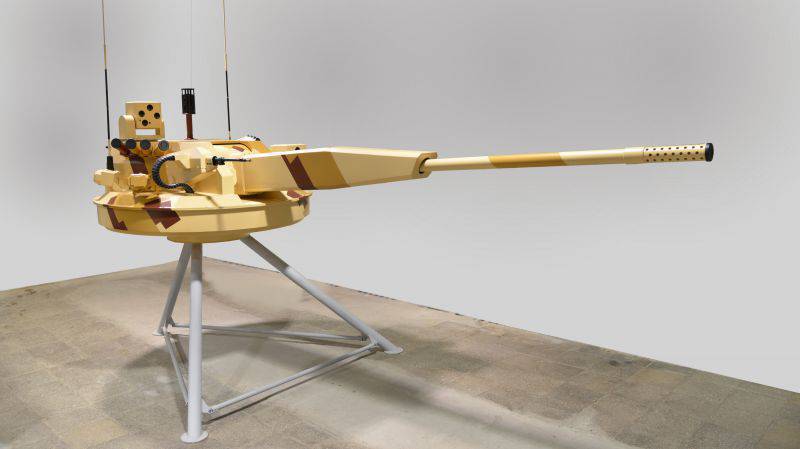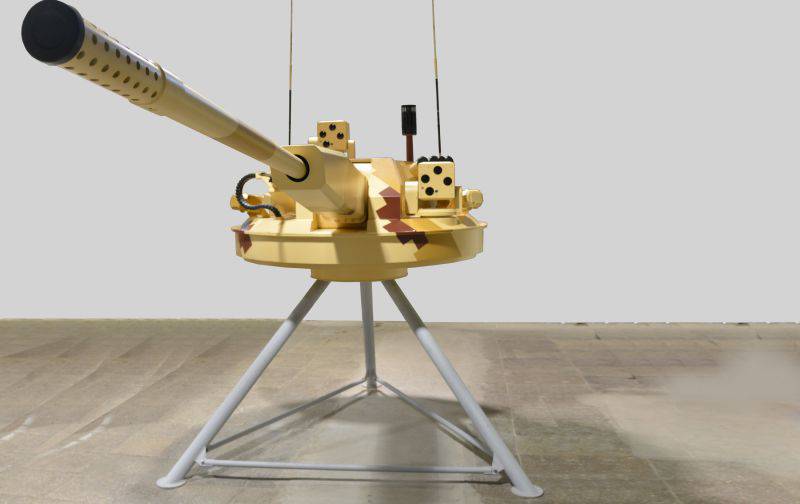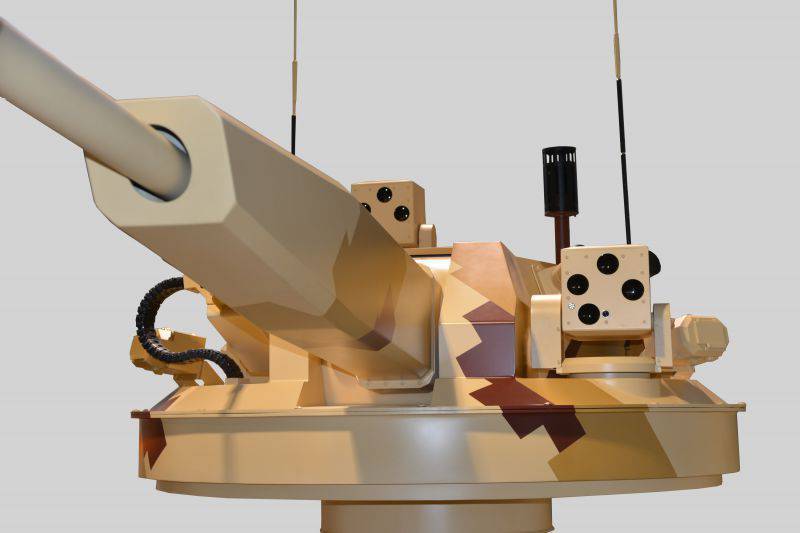Prospective anti-aircraft self-propelled gun with 57-mm gun: an attempt to forecast
15 July RIA News published an interview with the director general of the Petrel Research Institute Georgy Zakamennyh. The head of the company spoke about various aspects of work and new projects. Among other things, he mentioned the work on the project of the advanced anti-aircraft artillery complex. Such equipment, created in the interests of military air defense, will be equipped with a caliber 57 mm. A characteristic feature of this complex will be a combat module, which is rendered outside the vehicle. Management of all systems in this case will be carried out remotely.
Unfortunately, the CEO of the developer organization did not disclose the details of the new project. Only the caliber of the gun, the purpose and some features of the layout of the new complex for military air defense became known. However, previously published information about the projects of the Petrel Research Institute and other related organizations can serve as clues when trying to predict the appearance of a promising anti-aircraft artillery self-propelled gun. The fact is that Burevestnik specialists are currently engaged in the development of combat modules designed for use as part of equipment based on the latest unified platforms. In addition, several months ago, a draft combat module with an 57-mm automatic cannon was presented.
According to G. Zakamennykh, the new project is developing an 57-mm self-propelled rapid-fire anti-aircraft artillery complex. This information, as well as previously published information may be the basis for assumptions about the various features of a promising combat vehicle. Let's try to collect the available data and imagine what a new anti-aircraft complex could be.
Currently, the Russian army is composed of several anti-aircraft complexes of military air defense, equipped with artillery guns. First of all, it is self-propelled guns "Tunguska" and "Pantsir-С1". They carry 30-mm automatic guns designed to destroy short-range air targets. In addition to guns, these complexes are equipped with guided missiles, which increase the radius of action and increase the probability of destroying targets. Having a certain similarity at the level of the concept of armament, the Tunguska and Pantsir-С1 complexes are distinguished by basic chassis. They are based on tracked and wheeled chassis, respectively.
At the moment, one cannot even speak with confidence about the chassis class that will be used in the new project. However, the most likely option is to use a tracked chassis. This technique surpasses the wheeled technique in cross-country ability and other characteristics, which should provide high mobility to the new car. In addition, in this case, it will be possible to work in the same battle formations with tanks, BMP and other equipment.
Information on the use of tools caliber 57 mm is of greatest interest. For several decades, such weapons have actually been forgotten and were not used on the new equipment. Now there is a tendency to return such weapons. It is believed that 57 mm caliber guns are of great interest, since their power makes it possible to effectively deal with armored vehicles designed to protect against artillery of smaller calibers, mainly up to 30 mm. Thus, in the near future, the emergence of a number of guns, surpassing in caliber now common samples.
It should be noted that such weapons have already appeared in our country. At the beginning of this year, the Petrel Research Institute for the first time presented the new AU-220M combat module. This system is intended for installation on modernized and new combat vehicles of various types, which is expected to significantly increase their firepower. In addition, according to the developer, the AU-220M combat module can be used to attack air targets, which will lead to the expansion of the scope of combat vehicles.
Attention should be paid to the overall architecture of the new combat module. It is made in the form of a system installed on the roof of the body of the base machine, outside the habitable volume. A few days ago, the director general of the Petrel Research Institute was talking about this kind of architecture. Thus, there are grounds to believe that the module AU-220М or, rather, its modified version can be used as part of a promising anti-aircraft complex.
The combat module AU-220М is a special turret with weapons, fully mounted outside the internal volume of the combat vehicle. All the main equipment of the module is mounted on a support platform that is installed on a basic combat vehicle. An armor cover is provided on the upper surface of the platform, covering the breech of the gun and the automatic loader. In front of the casing there is a window for the gun. The 57 mm caliber gun has an uncharacteristically long mask that covers not only the breech, but also almost half of the barrel. The total length of the combat module reaches 5,82 m, the maximum width - 2,1 m, height, taking into account all units - up to 1,3 m.
The body of the combat module is assembled from armor plates of various thickness. Declared vserakursnaya protection units from bullets caliber 7,62 mm. The frontal projection of the module, in turn, is able to withstand the impact of a projectile caliber 30 mm. Thus, the combat module AU-220М is protected from most of the threats that arise on the battlefield at the present time, primarily from small arms and small-caliber artillery of the enemy.
To the left of the gun and on the upper surface of its casing two blocks with optical-electronic equipment are installed to search for targets and aim weapons. According to the developer, the sighting system includes optical and thermal imaging channels. The field of view of the equipment is stabilized in two planes. Laser rangefinders are also provided. The combat module is equipped with a fire control system that processes all the necessary information. It is possible to detect and attack targets in any weather conditions at any time of the day. The same sighting equipment is used to control the shooting of a cannon and a machine gun.
The main weapon of the military module AU-220M is a rifled gun caliber 57 mm. Tool mounting mechanisms provide vertical guidance within a sector from -5 ° to + 75 °. The rotation of the tower allows you to fire in any direction. An automatic cannon can fire at a rate of up to 200 shots per minute. Ammunition consists of 200 projectiles. The gun uses unitary shots with projectiles of several types. Depending on the tactical need, the operator of the combat module can use armor-piercing, high-explosive fragmentation or guided projectiles. The maximum effective range of fire reaches 12 km. To reduce the impact on the units of the combat module and the base machine, the gun is equipped with a muzzle brake.
To the right of the main gun on the combat module, in a special armored casing, a twin machine gun of caliber 7,62 mm is installed. Aiming the machine gun at the expense of mechanisms common with the gun. The power supply is made with the help of a flexible metal sleeve through which the cartridge belt passes. Inside the housing of the combat module are boxes on 2000 cartridges. Used machine gun allows you to attack manpower and unprotected equipment at distances to 1500 m.
According to available data, the project of the AU-220M combat module with a 57 mm caliber gun was developed specifically for the promising Atom wheeled infantry fighting vehicle being developed as part of Russian-French cooperation. After the recent events in the international arena, the combat vehicle development project was stopped, but work on the creation of a combat module, apparently, continued. The result was a "premiere" of the new system, held at the beginning of the year.
The well-known characteristics of the AU-220M system make it possible to give it a great future. Obviously, a combat vehicle with such weapons will have great advantages over all the armored personnel carriers, infantry fighting vehicles, etc. Due to the larger caliber gun, a certain gain in the effective shooting range of all types of projectiles, including armor-piercing, will be provided. In addition, 57-mm gun with the appropriate ammunition will have increased rates of armor penetration, which also affects the combat capabilities.
According to the developer, the new combat module is equipped with weapon guidance systems, which allow firing with elevation angles up to + 75 °. Thus, a hypothetical armored vehicle with the AU-220M module will be able to fight not only with ground targets, but also with a certain success to attack air. For effective destruction of aircraft, however, some modifications may be required.
Domestic and foreign experience shows that for use as part of an anti-aircraft self-propelled unit, a combat module must have some specific features. Thus, the maximum possible angle of elevation at the level of 80-85 ° is required. In addition, radar systems are required for detecting and tracking flying targets, as well as information processing equipment and automatic weapon control. The presence of optical-electronic systems is also important, but they are not sufficient in themselves to solve the tasks assigned.
Also requires some refinement of the gun and ammunition for it. The most promising and effective means of defeating air targets are high-explosive fragmentation artillery shells with controlled undermining. Existing systems of this class include a special programmable fuse and device-programmer. During the shot, the programmer enters the necessary data into the projectile, so that the warhead is undermined at a predetermined distance from the gun. Due to the accurate calculation of the pointing angles and the time of explosion of the projectile, an explosion occurs in the vicinity of the target, as a result of which it receives numerous damage from shrapnel.
It can be assumed that the use of 57-mm guns will significantly improve the combat effectiveness of the anti-aircraft system in comparison with existing complexes. Currently, most of these systems are equipped with guns of no more than 30-35 mm, which accordingly affects the power of the projectiles.
Based on the available information, we can assume that the promising anti-aircraft self-propelled artillery mounts, mentioned by G. Zakamennykh, will be equipped with a new modification of the AU-220М combat module, modified for use in air defense. As the chassis for this machine can be used various domestic tracked vehicles. At the same time, taking into account the latest developments in this area, it cannot be excluded that the basis for the promising self-propelled gun will be one of the newest unified chassis, for example, the Kurganets-25.
For obvious reasons, while you can only speculate. Nevertheless, the available information makes it possible to put forward certain ideas with certain confidence. How true will all these assumptions be - time will tell. However, it is already clear that the use of the new 57-mm gun will significantly improve the performance of the new anti-aircraft complex and provide significant superiority over other similar systems. It remains only to wait for new messages on an interesting topic and wait for the organization-developer to be ready to submit open information about its new project.
On the materials of the sites:
http://ria.ru/
http://arms-expo.ru/
http://burevestnik.com/
http://vpk.name/



Information